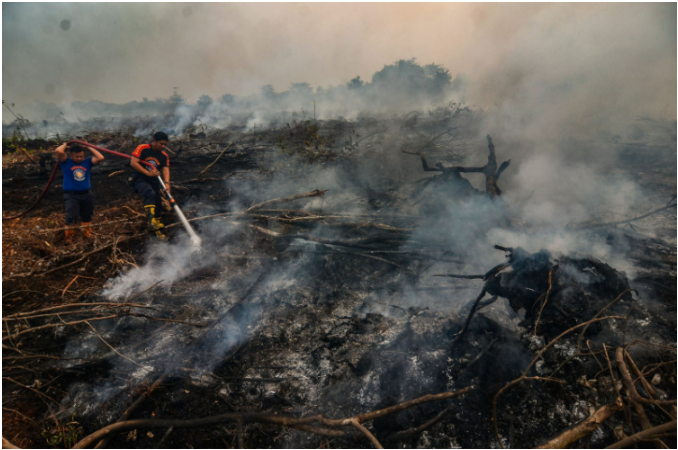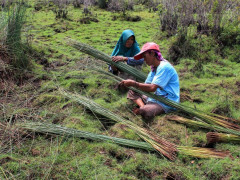Stepping into the Purun Fields of the Bararawa Peat Swamp
By Pantau GambutBagan Melibur Village's Efforts to Suppress Peat Fires using the Village Regulation concerning Ecosy

In February 2020, peatland fires hit Bagan Melibur Village, Merbau District, Meranti Islands in Riau Province. At least six hectares of bushland were burning for several weeks. Data from Pantau Gambut shows that peat fires annually occur in this village. To overcome these environmental issues, the village government has created regulations that are expected to reduce peat ecosystem damage.
Data on burned areas that were analyzed by Pantau Gambut revealed that 61.2 hectares of peatland were burned in Bagan Melibur Village in 2019.
Forest and land fires occur annually in the village. In fact, approximately 90% of the total 4,072 hectares of the village is a stretch of peat with a depth of up to seven meters, hence the fire will cause very dangerous emissions and haze.
Bagan Melibur Village has a total area of 4072.98 hectares which includes 3708 hectares of peat. The Bagan Melibur Village consists of three areas, namely Convertible Production Forest (HPK) with an area of 464.4 hectares, the Limited Production Forest (HPT) with an area of 1846.4 hectares, and Non-Forest Areas (APL) with an area of 1741 hectares.
Isnadi Esman, Head of Bagan Melibur Village, said that the condition of the peatlands in his village is quite alarming. In the dry season, like last February, the peat canals in his village are dry because many companies built canals that caused the surrounding peat to dry out. This makes the peat vulnerable to fire. A fire did break out and spread to parts of PT RAPP's acacia plantation concession area.
"We don't know why (it caught fire) last February. But the fire also (broke out) in the RAPP concession area. The peat was dry and the company’s canal was dry, with no water. Therefore, it’s vulnerable to fire," he said.
From the time the village was established until the fire last February, the village did not have adequate fire extinguishing equipment. They did not even have a fire extinguishing team. From this experience, Isnadi, who was just inaugurated in October 2019, then established the Fire Awareness Community (MPA) in April 2020.
“At that time there was no MPA. The fire extinguishing efforts (at that time) were carried out by the Head of Village, RT, RW together with the community. We only used the Robin (machine) in the past, but now we have the MPA. We’ve allocated the village funds to establish this team. The quality of fire extinguisher equipment, like the water pumps, has also improved. We’ve also prepared an 800 meter-long fire hose," Isnadi said.
Isnadi, who is a former Secretary General of the Riau Peat Community Network (JMGR), said that overcoming the vulnerability against peat fires in his area could not be done simply by extinguishing the fire. Therefore, for the past three months, the Village Representative Body (BPD) and he has drafted a comprehensive peat protection regulation. The peat protection program has also been included in the 2019-2025 Village Medium Term Development Plan (RPJMDes), which covers the Head of the Village’s 5-year term.
On 12 November 2020, the Village Government issued Village Regulation (Perdes) Number 9 of 2020 concerning the Peat and Mangrove Ecosystem-Based Rural Development. Seventeen articles in the regulations set forth the direction of the village development policies to optimize the potential of local resources, which include peatlands and mangroves, without resorting to fire-based land clearing methods
According to Miswar Zainuddin, Head of BPD Bagan Melibur, the unique characteristic of this village regulation is that it not only provides development and welfare improvement plans for one village but for an area. Five villages have the same commitment as Bagan Melibur Village with regards to gaining more benefits from the peatlands without sacrificing their sustainability.
“The BRG (Peat Restoration Agency) facilitated a meeting in the sub-district, a total of five villages and one urban village attended the meeting. However, the urban village withdrew its involvement during the second meeting. At the second meeting, we were united to work on and optimize peatlands and mangroves in five villages while maintaining sustainability," said Miswar Zainuddin, Head of BPD Bagan Melibur.
However, that does not mean that the BPD and the village government encountered no obstacles when they tried to implement this regulation. According to Miswar and Isnadi, the public must be made more aware. Especially during the pandemic when many villagers’ livelihood is affected. The Bagan Melibur community mostly consists of farmers, fishermen, and laborers. A number of companies have terminated their employment.
“There were many unemployed workers during the COVID-19 outbreak. Moreover, these workers are now looking for work in other countries. They don’t have much faith in the restoration program and the village regulation objectives. They usually receive a monthly salary and we are currently creating opportunities and have just started building. The first time we inform them of this opportunity, (they) don’t seem to have much faith in it," said Miswar.
In fact, many opportunities in the village and the programs specified in the village regulation are also promising. The village regulation includes efforts to realize restoration, revitalization, and compensation programs. The village government also established Village-Owned Enterprises or BUMDES and along with the five other villages, they have also established Joint Village-Owned Enterprises or BUMDESMA.
Isnadi said a number of peatlands-based welfare improvement programs have started to be implemented. Among others: planting sago trees, an endemic plant, in 35 hectares of fire-prone peat shrub areas. The sago seedlings were also planted in a 15 hectares old rubber plantation area. The farmers sell sago directly to the collectors using the ijon system. The farmers received their money before harvest, but they were already out of money by harvest season. Some farmers even had to borrow money from the collectors.
In line with the village regulation, the sago plantation program will create alternative non-land-based livelihood sources. Sago will be used as animal feed, such as poultry and cattle. A trial is currently being carried out on 18 cows. The sago is mixed with local plants, to increase its vitamins and nutritional content. "We were assisted by the BRG who brought in a team of experts from IPB", said Isnadi.
"We did a test, simple research on how the processed sago can be used as animal feed. If this is successful, we can create alternative livelihood sources for the community whose main income derives from the land-based activities and try to shift it to non-land-based activities," Isnadi said.
The livestock business development will also be strengthened by reforming the farming business institutions. Administratively, the livestock business will be equipped to be able to receive funding assistance. In preparation for this, the village government has established BUMDES and BUMDESMA for five villages.
“This program aims to increase the active role of communities in processing peat, especially making use of abandoned land, shrubs, and mangroves to increase their livelihood. There will be mangrove planting and fish nurseries in the mangrove area, which also serves as an effort to anticipate high abrasion" he said.
Isnadi and Miswar are very confident that these programs will be able to shift the focus of land-based economic activities to non-land-based sources of income. Moreover, the government seems supportive of these activities.
“We don't want the massive peat fires of 2011, 2012, and 2015 to happen again in Bagan Melibur. The programs that were originally proposed by the districts to villages are now being proposed by villages to districts. The response has been relatively promising. This is what the district government is hoping for, especially in relation to efforts to control peat fires in the districts and in the province of Riau,” said Miswar.
Romes Irawan Putra, Coordinator of Simpul Jaringan Pantau Gambut Riau, said that the Bagan Melibur Village government and community, through the village regulations, carried out a positive grassroot breakthrough. COVID-19 has greatly affected the community’s livelihoods. Through the animal feed production program and serious support from various parties, this program will be able to create alternative sources of livelihood.
“The pressure on peat will be reduced. Furthermore, village regulations and full awareness from the communities can bind all the parties operating in the village area, including HTI companies. Because the peatland damage in the village also affected the companies who have dug canals and made the peat dry in HTI expansion area,” he explained.
He added that this initiative should be acknowledged by the provincial government, which is currently launching the Riau Hijau initiative, where restoration is an absolute requirement in the Riau Governor’s flagship program. “Peat restoration does not only cover the construction of wetting infrastructure, but also the effort of building the awareness of village government and the community on how peat restoration could be beneficial to the ecosystem and economy. This program can be duplicated in other fire-prone villages in Riau,” added Romes.



